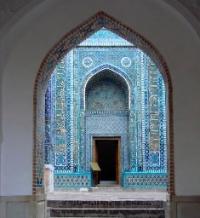Вы здесь
Mausoleum of Khoja-Ahmad.

Pay for a guided tour in Samarkand.
"... may Allah prolong their eternity so that the graves of Khoja-Ahmad's happiness lit up with the garden become..."
Architectural tourism in the cities of Uzbekistan.
The mausoleum of Khoja Ahmad, located across the corridor, dates back to the beginning of the XIV century. From the mausoleum survived only the portal. In the study of the foundations of this mausoleum in 1922, the first real crypt in Central Asia was not found with gravestones, as was previously encountered, with two skeletons in wooden coffins.
This discovery brought new coverage to the burial cult of Muslims of the first half of the XIV century. Both mausoleums belong to Timurov time. On these architectural monuments there are irrigation bricks, painted majolica and relief glazed tiles; the mosaic appeared only in Timurov time.
The name of the ceramist Fakhri Ali, who decorated the portal of Khoja Ahmad, is woven into the figured sheet of floral ornament. The absence of a nisba - the master's birthplace - testifies to his local Samarkand origin.
In 1961 - 1962, the portal was rebuilt and the mausoleum's external facing was made. The northern part of the courtyard closes the Khodja-Ahmad mausoleum, built back in the pre-Timur period around the 1340s (XIV century).
Enlightener:
G.A. Pugachenkova.
Photos by
Alexander Petrov.







